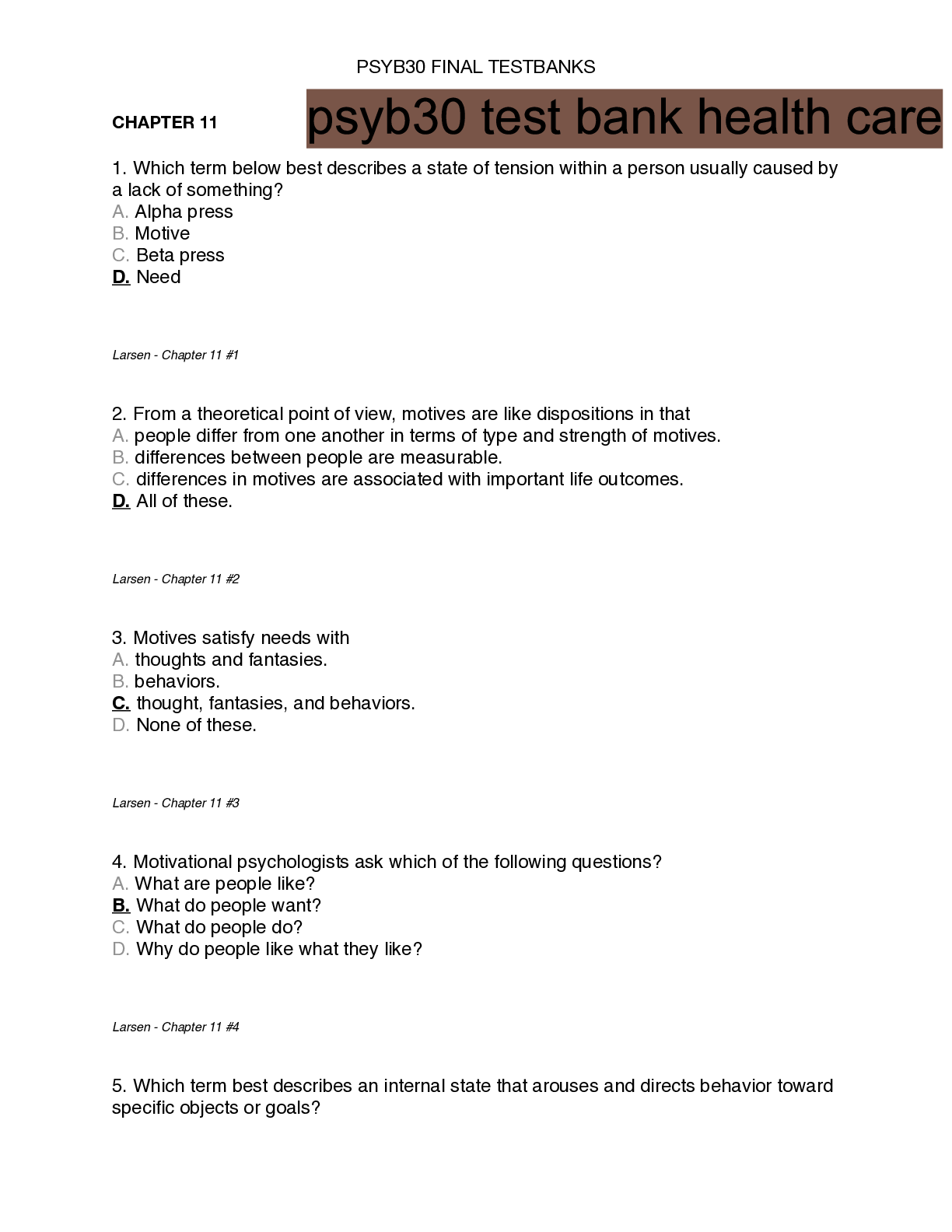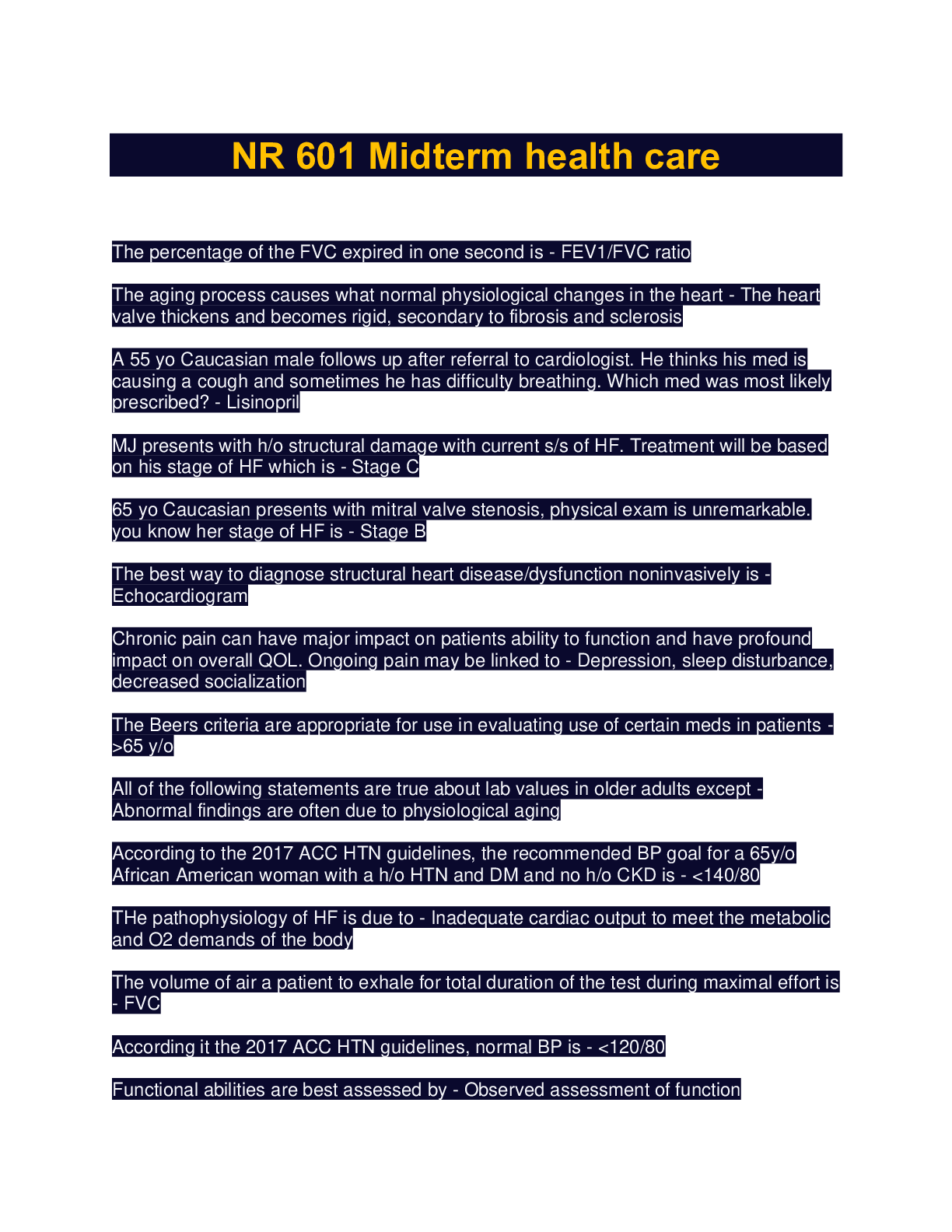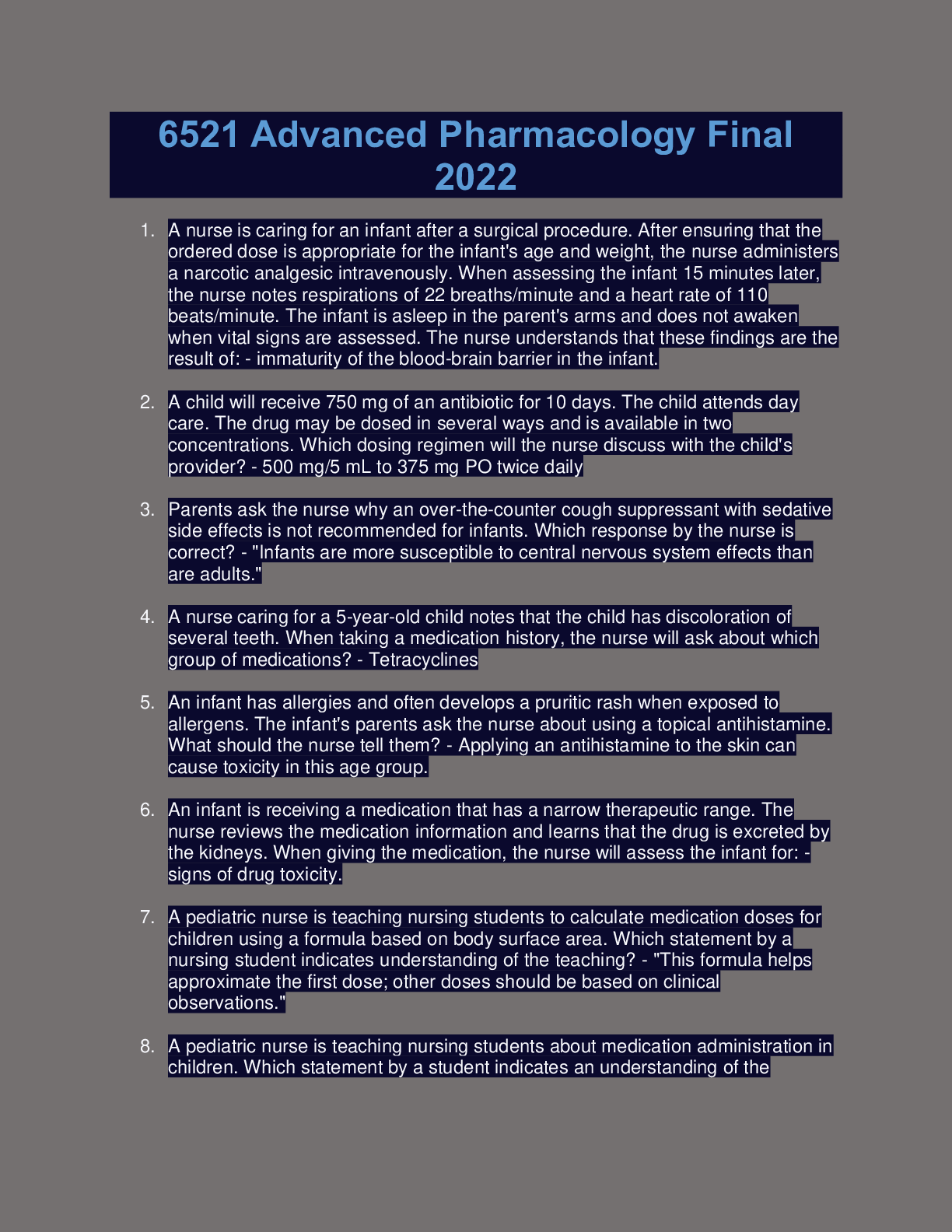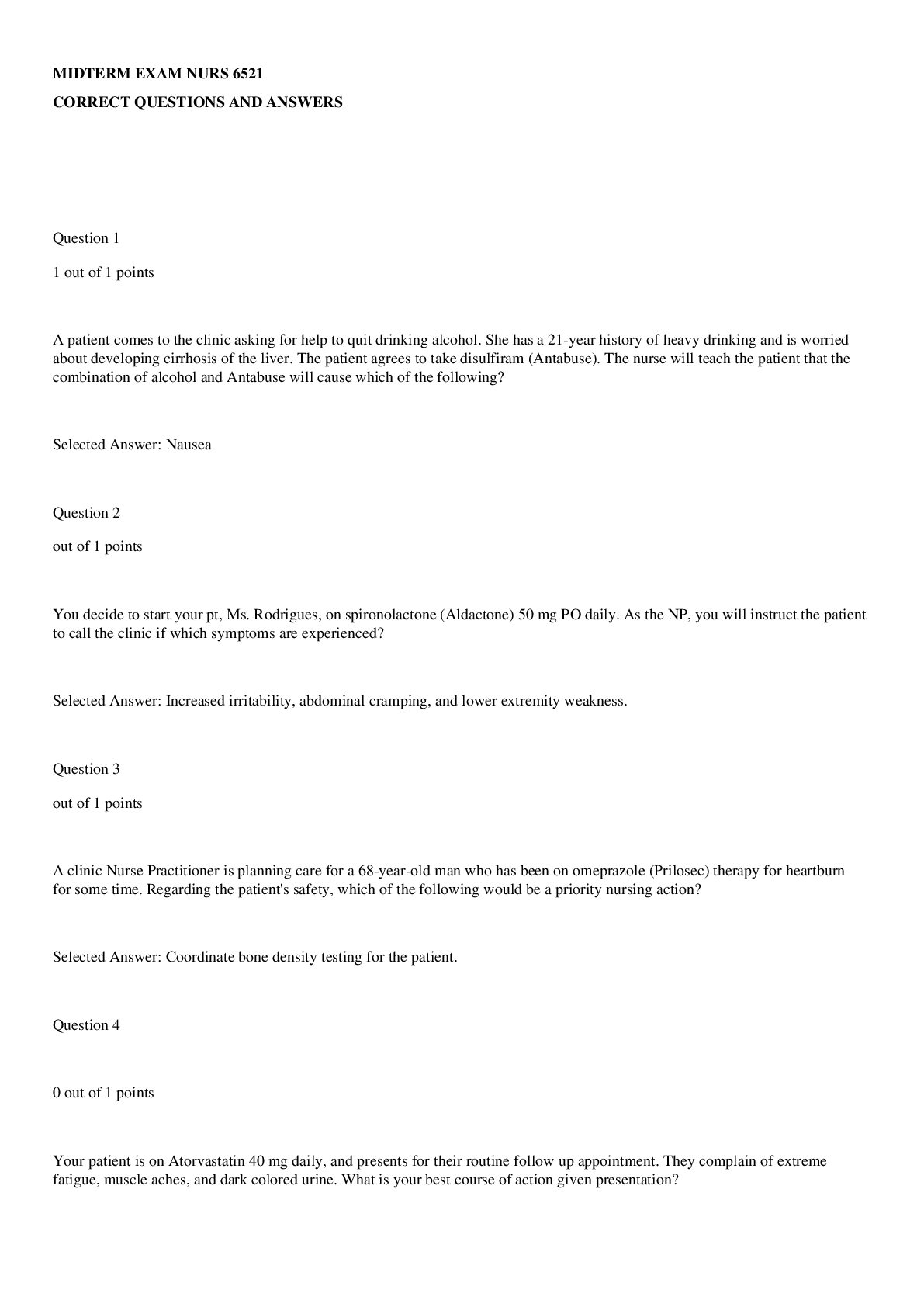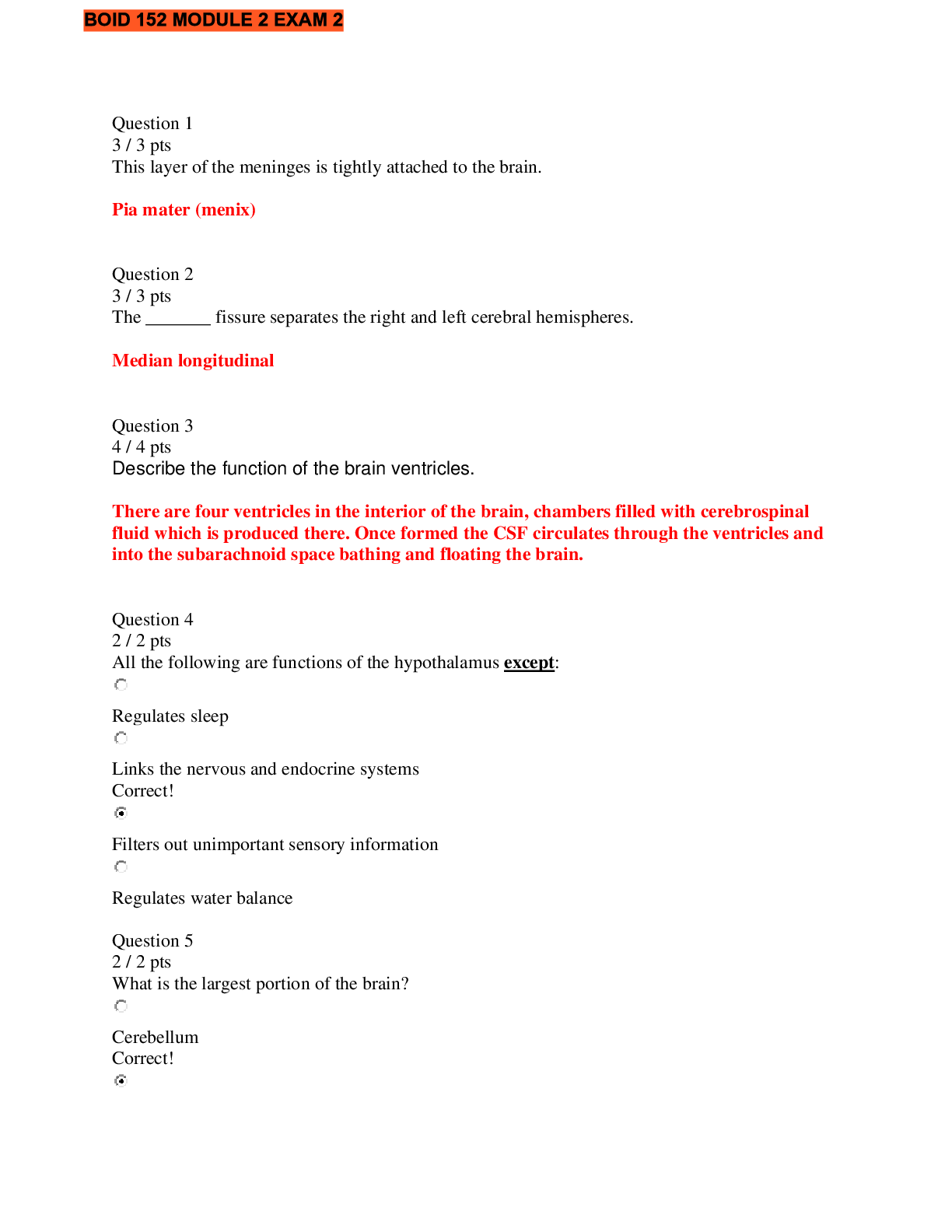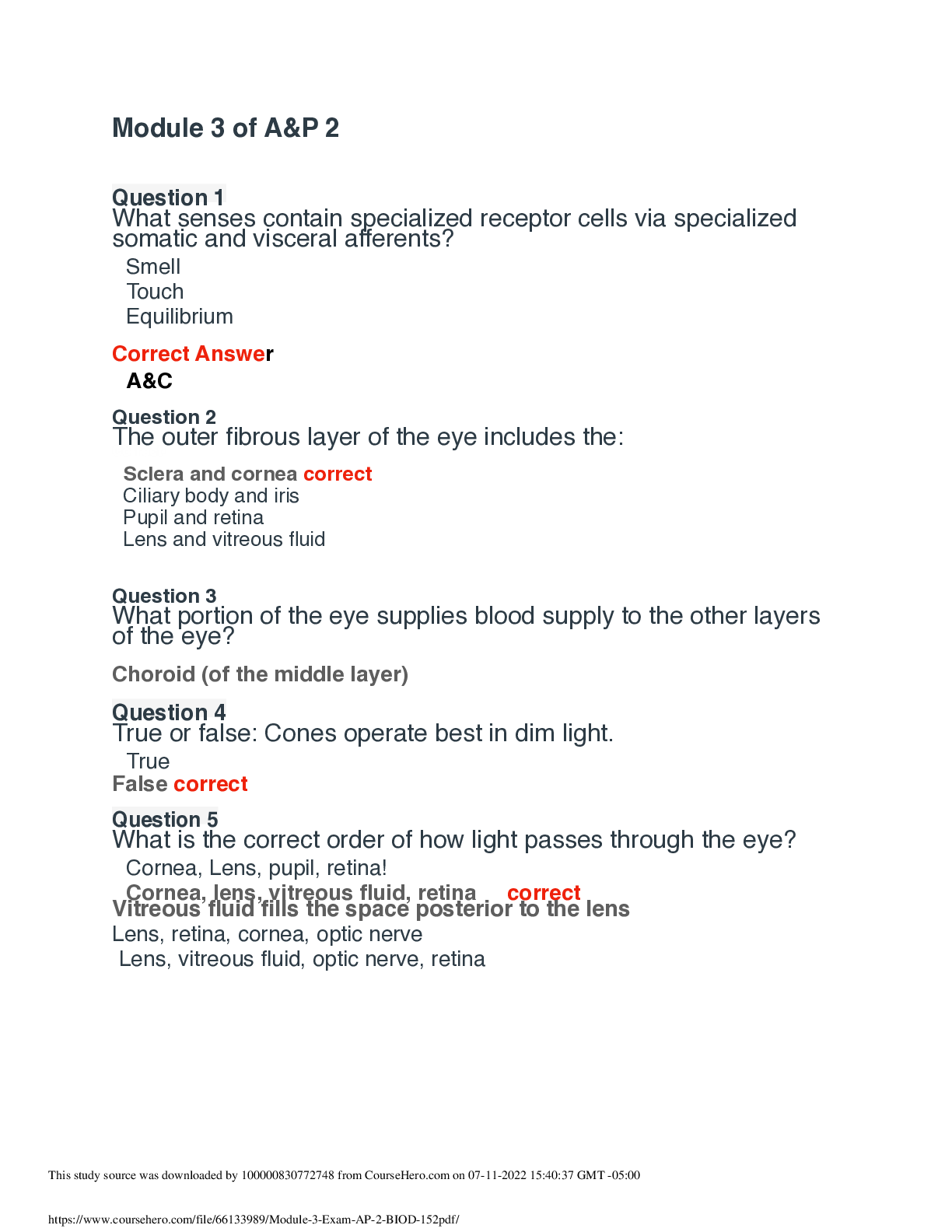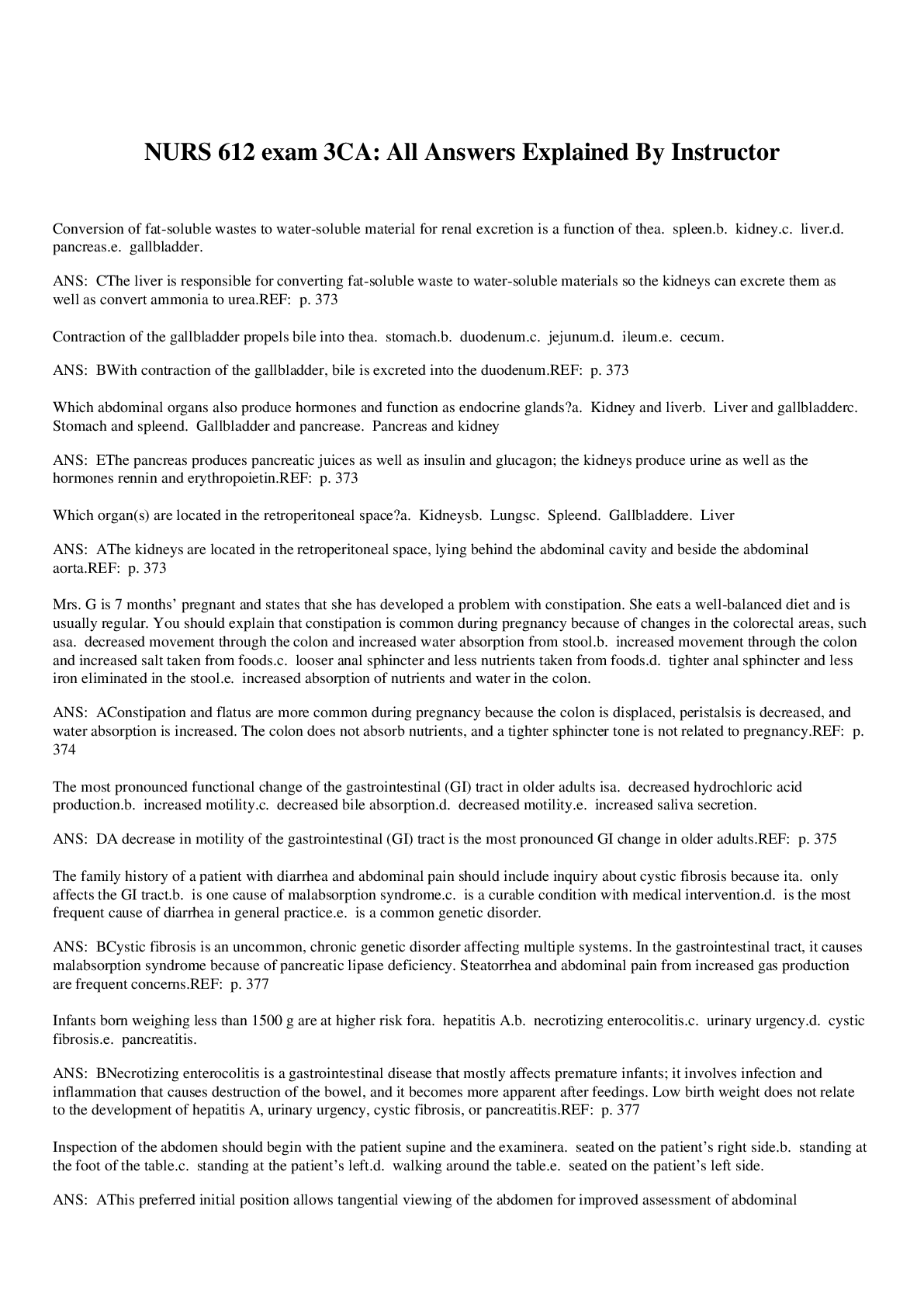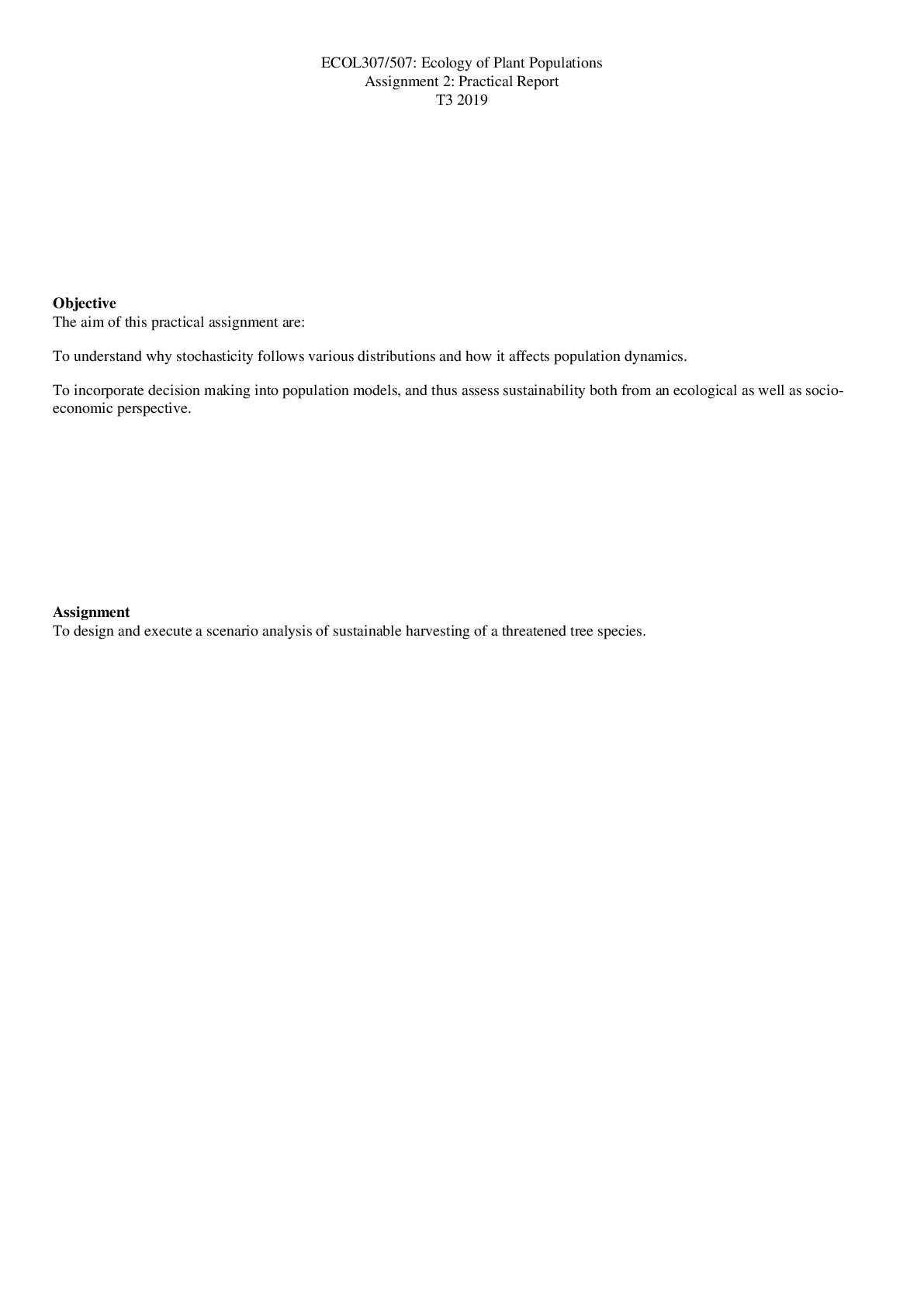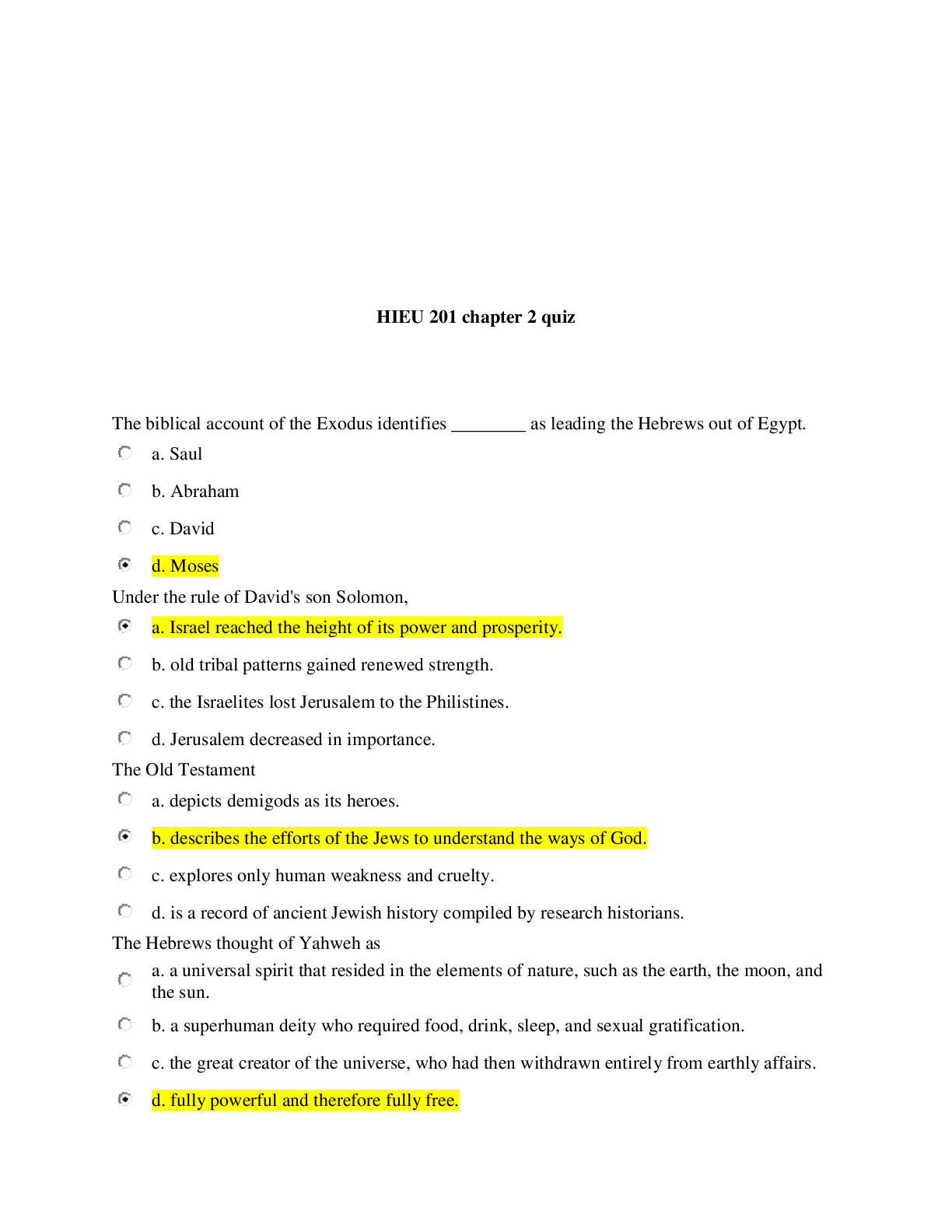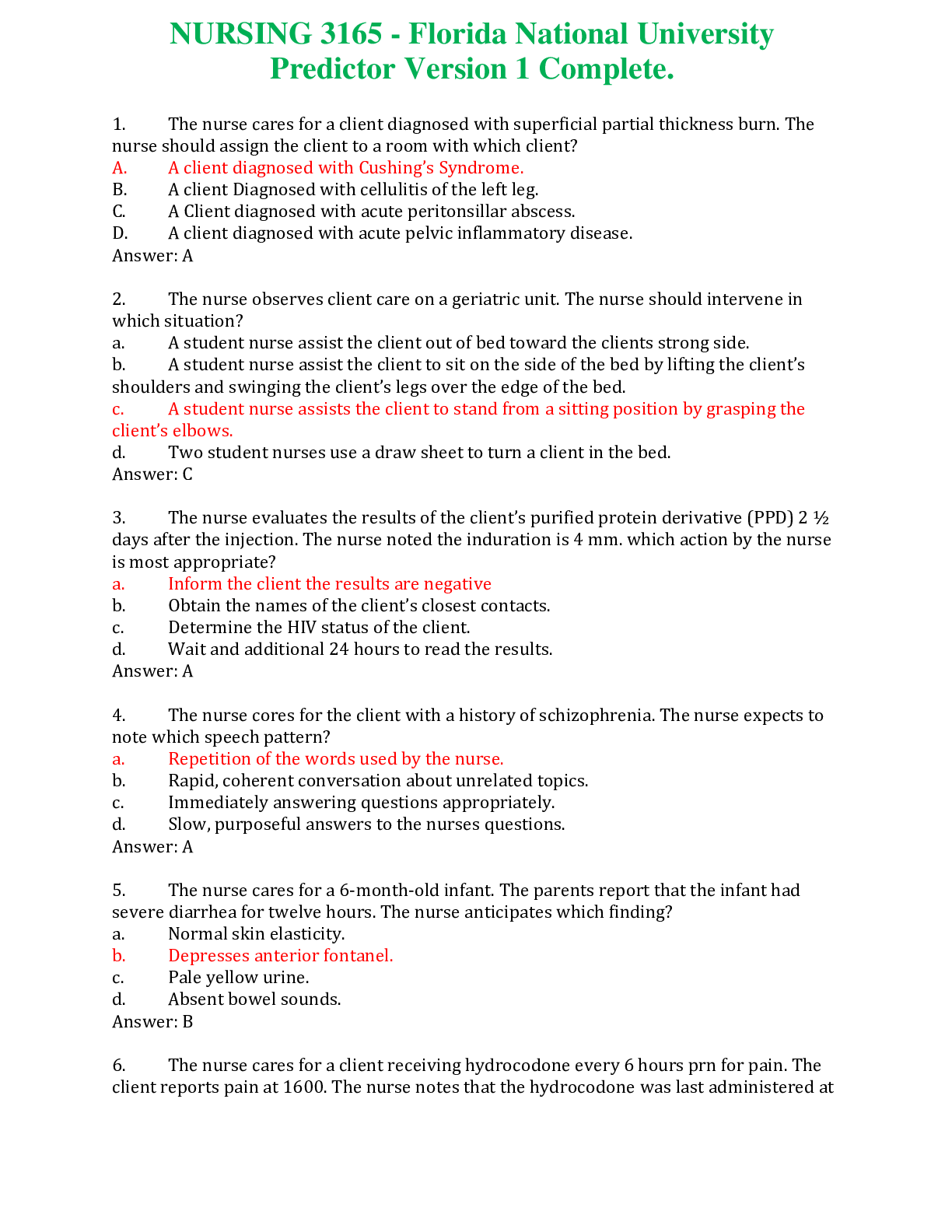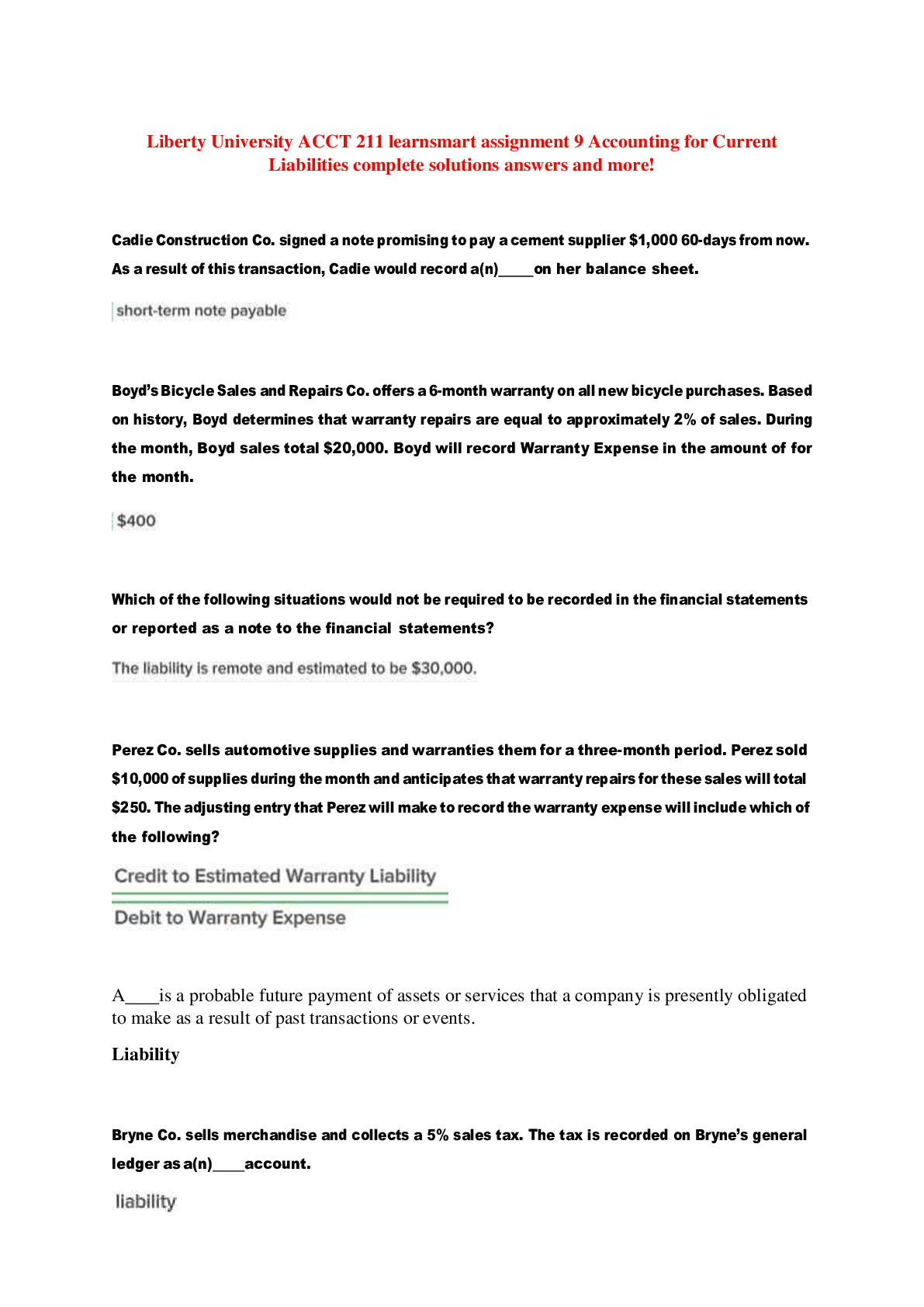*NURSING > QUESTIONS & ANSWERS > Interpersonal Relationships, 7th Edition (All)
Interpersonal Relationships, 7th Edition
Document Content and Description Below
1. When describing nursing to a group of nursing students, the nursing instructor lists all of the following characteristics of nursing except a. historically nursing is as old as mankind. b. nursi... ng was originally practiced informally by religious orders dedicated to care of the sick. c. nursing was later practiced in the home by female caregivers with no formal education. d. nursing has always been identifiable as a distinct occupation. ANS: A Historically, nursing is as old as mankind. Originally practiced informally by religious orders dedicated to care of the sick and later in the home by female caregivers with no formal education, nursing was not identifiable as a distinct occupation until the 1854 Crimean war. There, Florence Nightingale’s Notes on Nursing introduced the world to the functional roles of professional nursing and the need for formal education. DIF: Cognitive Level: Comprehension REF: p. 1 TOP: Step of the Nursing Process: All phases MSC: Client Needs: Psychosocial Integrity 2. The nursing profession’s first nurse researcher, who served as an early advocate for high-quality care and used statistical data to document the need for handwashing in preventing infection, was a. Abraham Maslow. b. Martha Rogers. c. Hildegard Peplau. d. Florence Nightingale. ANS: D An early advocate for high-quality care, Florence Nightingale’s use of statistical data to document the need for handwashing in preventing infection marks her as the profession’s first nurse researcher. DIF: Cognitive Level: Knowledge REF: p. 1 TOP: Step of the Nursing Process: All phases MSC: Client Needs: Management of Care 3. Today, professional nursing education begins at the a. undergraduate level. b. graduate level. c. advanced practice level. d. administrative level. ANS: A Today, professional nursing education begins at the undergraduate level, with a growing number of nurses choosing graduate studies to support differentiated practice roles and/or research opportunities. Nurses are prepared to function as advanced practice nurse practitioners, administrators, and educators. DIF: Cognitive Level: Comprehension REF: p. 2 TOP: Step of the Nursing Process: All phases MSC: Client Needs: Management of Care 4. Nursing’s metaparadigm, or worldview, distinguishes the nursing profession from other disciplines and emphasizes its unique functional characteristics. The four key concepts that form the foundation for all nursing theories are a. caring, compassion, health promotion, and education. b. respect, integrity, honesty, and advocacy. c. person, environment, health, and nursing. d. nursing, teaching, caring, and health promotion. ANS: C Individual nursing theories represent different interpretations of the phenomenon of nursing, but central constructs—person, environment, health, and nursing—are found in all theories and models. They are referred to as nursing’s metaparadigm. DIF: Cognitive Level: Knowledge REF: p. 2 TOP: Step of the Nursing Process: All phases MSC: Client Needs: Management of Care 5. When admitting a client to the medical-surgical unit, the nurse asks the client about cultural issues. The nurse is demonstrating use of the concept of a. person. b. environment. c. health. d. nursing. ANS: B The concept of environment includes all cultural, developmental, and social determinants that influence a client’s health perceptions and behavior. A person is defined as the recipient of nursing care, having unique bio-psycho-social and spiritual dimensions. The word health derives from the word whole. Health is a multidimensional concept, having physical, psychological, sociocultural, developmental, and spiritual characteristics. The World Health Organization (WHO, 1946) defines health as “a state of complete physical, mental, social well-being, not merely the absence of disease or infirmity.” Nursing includes the promotion of health, prevention of illness, and the care of ill, disabled, and dying people. DIF: Cognitive Level: Application REF: p. 3 TOP: Step of the Nursing Process: Assessment MSC: Client Needs: Psychosocial Integrity 6. A young mother tells the nurse, “I’m worried because my son needs a blood transfusion. I don’t know what to do, because blood transfusions cause AIDS.” Which central nursing construct is represented in this situation? a. Environment b. Caring c. Health d. Person ANS: D The concept of environment includes all cultural, developmental, and social determinants that influence a client’s health perceptions and behavior. Caring is not one of the four central nursing constructs. The word health derives from the word whole. Health is a multidimensional concept, having physical, psychological, sociocultural, developmental, and spiritual characteristics. The World Health Organization (WHO, 1946) defines health as “a state of complete physical, mental, social well-being, not merely the absence of disease or infirmity.” Nursing includes the promotion of health, prevention of illness, and the care of ill, disabled, and dying people. Person is defined as the recipient of nursing care, having unique bio-psycho-social and spiritual dimensions. DIF: Cognitive Level: Application REF: p. 2 TOP: Step of the Nursing Process: Implementation MSC: Client Needs: Psychosocial Integrity 7. The nurse performs a dressing change using sterile technique. This is an example of which pattern of knowledge? a. Empirical b. Personal c. Aesthetic d. Ethical ANS: A Empirical knowledge is the scientific rationale for skilled nursing interventions. Personal ways of knowing allow the nurse to understand and treat each individual as a unique person. Aesthetic ways of knowing allow the nurse to connect in different and more meaningful ways. Ethical ways of knowing refer to the moral aspects of nursing. DIF: Cognitive Level: Comprehension REF: p. 5 TOP: Step of the Nursing Process: Implementation MSC: Client Needs: Management of Care 8. The nurse-client relationship as described by Hildegard Peplau a. would not be useful in a short-stay unit. b. allows personal and social growth to occur only for the client. c. facilitates the identification and accomplishment of therapeutic goals. d. focuses on maintaining a personal relationship between the nurse and client. ANS: C Hildegard Peplau offers the best-known nursing model for the study of interpersonal relationships in health care. Her model describes how the nurse-client relationship can facilitate the identification and accomplishment of therapeutic goals to enhance client and family wellbeing. In contemporary practice, Peplau’s framework is more applicable today in longer term relationships, and in settings such as rehabilitation centers, long-term care, and nursing homes. Despite the brevity of the alliances in acute care settings, basic principles of being a participant observer in the relationship, building rapport, developing a working partnership, and terminating a relationship remain relevant. DIF: Cognitive Level: Knowledge REF: p. 10 TOP: Step of the Nursing Process: All phases MSC: Client Needs: Psychosocial Integrity 9. The identification phase of the nurse-client relationship a. sets the stage for the rest of the relationship. b. correlates with the assessment phase of the nursing process. c. focuses on therapeutic goals to enhance client and family well-being. d. uses community resources to help resolve health care issues. ANS: C Hildegard Peplau offers the best-known nursing model for the study of interpersonal relationships in health care. Her model describes how the nurse-client relationship can facilitate the identification and accomplishment of therapeutic goals to enhance client and family wellbeing. DIF: Cognitive Level: Knowledge REF: p. 10 TOP: Step of the Nursing Process: Implementation MSC: Client Needs: Management of Care 10. Abraham Maslow's needs theory is a framework that a. begins with meeting basic psychosocial needs first. b. ensures essential needs are satisfied, then people move into higher physiological areas of development. c. proposes that people are motivated to meet their needs in a descending order. d. nurses use to prioritize client needs and develop relevant nursing approaches. ANS: D Abraham Maslow's needs theory is a framework that nurses use to prioritize client needs and develop relevant nursing approaches. Maslow's model proposes that people are motivated to meet their needs in an ascending order beginning with meeting basic survival needs. As essential needs are satisfied, people move into higher psychosocial areas of development. DIF: Cognitive Level: Application REF: p. 10 TOP: Step of the Nursing Process: All phases MSC: Client Needs: Psychosocial Integrity 11. Which of the following statements about communication theory is true? a. Primates are able to learn new languages to share ideas and feelings. b. Concepts include only verbal communication. c. Perceptions are clarified through feedback. d. Past experience does not influence communication. ANS: C Feedback is the only way to know that one’s perceptions about meanings are valid. Human communication is unique. Only human beings have large vocabularies and are capable of learning new languages as a means of sharing their ideas and feelings. Communication includes language, gestures, and symbols to convey intended meaning, exchange ideas and feelings, and to share significant life experience. To encode a message appropriately requires a clear understanding of the receiver’s mental frame of reference (e.g., feelings, personal agendas, past experiences) and knowledge of its purpose or intent of the communication. DIF: Cognitive Level: Knowledge REF: p. 7 TOP: Step of the Nursing Process: Assessment MSC: Client Needs: Psychosocial Integrity 12. In the circular transactional model of communication, a. questions are framed in order to recognize the context of the message. b. people take only complementary roles in the communication. c. the context of the communication is unimportant. d. the purpose of communication is to influence the receiver. ANS: A A circular model expands linear models to include the context of the communication, feedback loops, and validation. With this model, the sender and receiver construct a mental picture of the other, which influences the message and includes perceptions of the other person’s attitude and potential reaction to the message. DIF: Cognitive Level: Comprehension REF: p. 8 TOP: Step of the Nursing Process: All phases MSC: Client Needs: Psychosocial Integrity 13. The nurse recognizes that feedback loops a. do not allow for correction of original information. b. are solely based on the General Systems Theory. c. do not allow for validation of information. d. allow the human system to correct its original information. ANS: D Feedback (from the receiver or the environment) allows the system to correct or maintain its original information. Feedback loops (from the receiver, or the environment) validate the information, or allow the human system to correct its original information. General Systems Theory, initially described by Ludwig von Bertalanffy (1968), focuses on process and interconnected relationships comprising the “whole.” DIF: Cognitive Level: Knowledge REF: p. 8 TOP: Step of the Nursing Process: All phases MSC: Client Needs: Psychosocial Integrity 14. Which of the following statements best represents therapeutic communication when a student discovers a client crying in bed? a. “I am the nurse who will be doing your treatments today.” b. “Will you listen to me so I can help you get better?” c. “This is what is going to happen during surgery.” d. “Can we talk about what seems to be bothering you?” ANS: D Asking about what is bothering the client is goal directed. Its purpose is to promote client wellbeing. “I am the nurse who will be doing your treatments today” is a statement of fact, and it ignores the client’s emotional needs. “Will you listen to me so I can help you get better?” is not goal directed and does not involve mutuality. “This is what is going to happen during surgery” is simply one way. It does not engage the client in a therapeutic manner. DIF: Cognitive Level: Application REF: p. 10 TOP: Step of the Nursing Process: Assessment MSC: Client Needs: Psychosocial Integrity 15. The central constructs of person, environment, health, and nursing are found in all nursing theories and models and are referred to as a. telehealth. b. the medical model. c. nursing’s metaparadigm. d. five core areas of competency. ANS: C Individual nursing theories represent different interpretations of the phenomenon of nursing, but central constructs—person, environment, health, and nursing—are found in all theories and models. They are referred to as nursing’s metaparadigm. These constructs are the “metalanguage” of nursing, and together they act as basic building blocks for the discipline of professional nursing. Telehealth is fast becoming an integral part of the health care system, used both as a live interactive mechanism (particularly in remote areas, where there is a scarcity of health care providers) and as a way to track clinical data. Two important outcomes are reduced health costs and increased access to care. During the last century, the bulk of professional care was delivered in acute care settings, based on the disease-focused medical model. Switching to today’s community focus recognizes the fact that chronic medical conditions account for most of today’s care, with most being treated in the community. The IOM report Health professions education: A bridge to quality (2003) calls for the restructuring of clinical education responsive to the 21st century health system transformation goals of providing the highest quality and safest medical care possible. This report identified five core areas of competency required to cross the bridge to quality. [Show More]
Last updated: 1 year ago
Preview 1 out of 658 pages
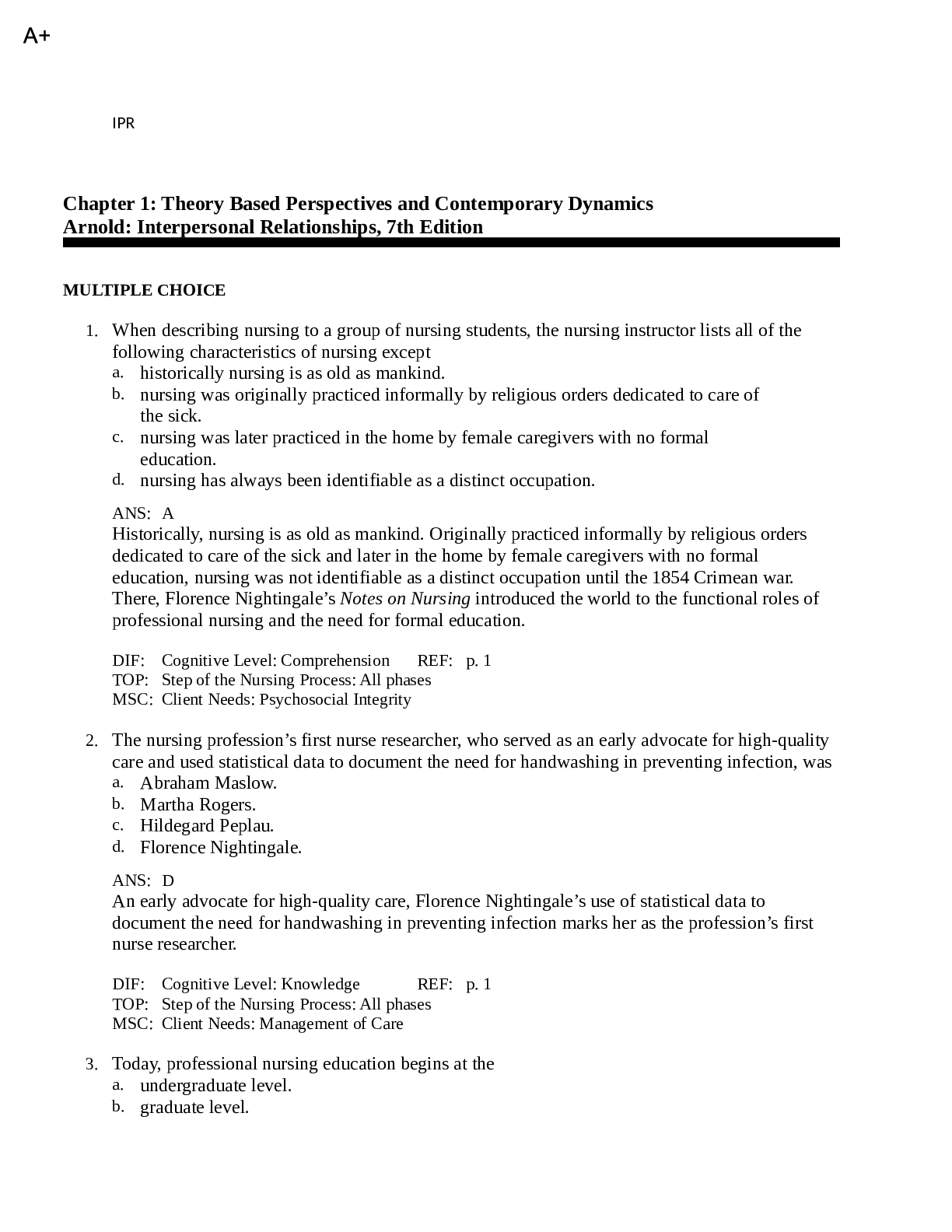
Buy this document to get the full access instantly
Instant Download Access after purchase
Add to cartInstant download
We Accept:

Reviews( 0 )
$10.50
Document information
Connected school, study & course
About the document
Uploaded On
Oct 01, 2022
Number of pages
658
Written in
Additional information
This document has been written for:
Uploaded
Oct 01, 2022
Downloads
0
Views
61

